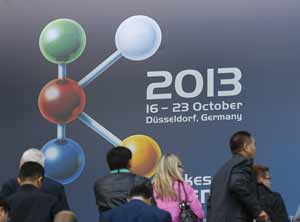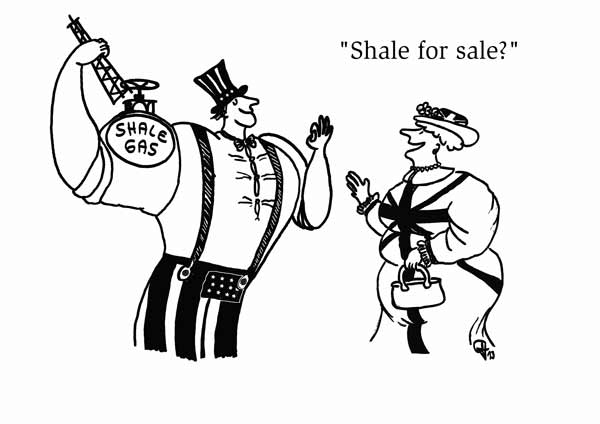YEAR IN REVIEW 2013
Part 1 – General overview: US shale gas boom has European plastics players worried / Commodity sectors dogged by overcapacity, insolvencies / Italy goes all out for biopolymers / Mixed picture for European converters
 The impressive "K 2013" trade fair proved once again it is the undisputed leader worldwide (Photo: Messe Düsseldorf) |
As the old year staggers toward its inevitable end in a frenzy of fireworks and New Year’s resolutions, many publications review the most important events of the past twelve months. Even Facebook has now picked up the thread, reminding users, their friends and advertisers of what they did between January and December. In Plasteurope.com’s review of 2013, we cast a backward glance at the year’s hot-button issues. What were the major trends in the European plastics industry and how did the markets react? Which plastics producers, converters and machinery makers made the news? What were their tops and flops?
As is the case every three years, the world’s largest plastics trade fair “K”, dominated the headlines for a week in October. The jewel in the crown of international trade exhibitions was once again a showcase for quality, even if it did not set new attendance records, organiser Messe Düsseldorf said. Manufacturers of high-tech plastics machinery were especially pleased with the high level of orders received.
Without doubt, this year’s most talked-about topic was the US shale gas boom, which also goes by such aliases as shale gas revolution or “game changer.” Even if it is not yet clear whether worldwide reserves are as substantial as many fracking advocates purport or whether the current hype will be the fossil fuels industry’s last hurrah. The envisaged potential alone has led US gas prices to drop to new lows and seriously threatened the economics of plastics production not only in Europe, but also in the Middle East.
As is the case every three years, the world’s largest plastics trade fair “K”, dominated the headlines for a week in October. The jewel in the crown of international trade exhibitions was once again a showcase for quality, even if it did not set new attendance records, organiser Messe Düsseldorf said. Manufacturers of high-tech plastics machinery were especially pleased with the high level of orders received.
Without doubt, this year’s most talked-about topic was the US shale gas boom, which also goes by such aliases as shale gas revolution or “game changer.” Even if it is not yet clear whether worldwide reserves are as substantial as many fracking advocates purport or whether the current hype will be the fossil fuels industry’s last hurrah. The envisaged potential alone has led US gas prices to drop to new lows and seriously threatened the economics of plastics production not only in Europe, but also in the Middle East.
 |
Executives at leading European plastics producers make no secret of the fact that they will look carefully at the US when deciding where to locate new plants. Others are examining the prospects for importing shale gas-derived ethane from the US. Presenting BASF’s Q3 2013 results to journalists in late October, CEO Kurt Bock noted that "all of Europe’s major chemical producers are looking for investment in the US, and this will have a negative effect on European capacities."
Among European players without extensive assets on the other side of the Atlantic, Ineos has raced quickly toward the goalpost, in October launching a coup that surely would have made the board chairman, Jim Ratcliffe, PIE’s Person of the Year – if we had one. After forcing the trade union Unite to accept wage and pension cuts, arguing that without access to cheap ethane the company was unable to compete with its US rivals, the company nailed down GBP 200m in grants and loans for an import terminal in the UK, a country it turned its back on in 2011 when it moved headquarters to Switzerland.
Even without the shale gas boom having yet knocked out any players, many European polymer producers and their customers were under clearly pressure, as falling domestic demand from applications such as automotive and building stung. In Spain and Italy, the economy had not yet recovered from the twin economic and currency crises. While building new capacity in Asia or North America, the multinational players generally restricted themselves to replacement investments at home. In some cases, aging capacities were to be replaced by larger and back-integrated large-scale units with better economies of scale.
Carrying through with plans announced in 2012, Dow Chemical shuttered its HDPE plant at Tessenderlo / Belgium in Q2 2013. Total announced it would close its 70,000 t/y PS plant at Stalybridge / UK and concentrate styrenics production at Carling / France. Later, Total said it would close a smaller cracker and PE plant at Antwerp / Belgium after start-up of more innovative facilities. Dutch-based LyondellBasell closed its 100,000 t/y HDPE plant at Wesseling / Germany while Austria’s Borealis revealed plans to close its production of HDPE at Burghausen / Germany by the end of 2014 and concentrate on PP.
As readers of PIE’s price reports are well aware, polymer prices bounced up all over the charts again in 2013. Negative trends such as global overcapacity claimed victims, as weaker or overextended players were forced into insolvency and market consolidation accelerated. Along with PVC – vibrant practically nowhere in Europe – PET players have had a rough ride this year. In March, vinyls producer Kem One, set free by Arkema in 2012, filed for bankruptcy in France, and in June the boom was lowered on Spanish polyester producer La Seda.
Unable to pay its debts after an ill-advised acquisition spree, the Spanish company landed in a Barcelona bankruptcy court, where liquidation of assets ranging from feedstock production to polymerisation and recycling proceeded swiftly. As of mid-December, only one of its former plants looked likely to continue producing. At Polisan Hellas, as Artenius Hellas was renamed after its acquisition by Turkey’s Polisan Holding in September, the new owner planned to resume production in December with a capacity of 100,000 t/y.
Together, Ineos and Belgium’s Solvay took a giant step toward consolidation of the European vinyls market, unveiling plans to merge their operations into a 50:50 joint venture with pro forma net sales of EUR 4.3 bn and PVC production capacity of around 3.2m t/y. At press time, European competition authorities were still stalling on whether to allow the deal that would create the region’s largest and the world’s third-largest player.
In Italy, thermoplastics output declined across all market segments. Even in the absence of an official death certificate, the frosty silence that settled over the ruins of the PVC industry seemed to indicate even the unions and the minister of economic development had given up trying to resuscitate the moribund patient. Other traditional plastics businesses began to fade as Versalis sought to increase the share of speciality and green products in its portfolio. In perhaps the most encouraging development the country has seen in years, the Eni subsidiary pressed ahead with converting the old petrochemicals site at Porto Torres in Sardinia into a bioplastics hub, in cooperation with leading bioplastics player, Novamont.
The European plastics machinery and processing landscape is too diversified to conform to uniform trends. Suffice it to say, bigger is generally better, and the more people drive and build, the more profitable the industry’s players are. Converter groupings in the UK and Germany reported fairly encouraging business trends in 2013, with their counterparts in France pointing to a decline in business. Farther east, Polish business began to weaken, while Turkish converters saw double-digit growth.
European automotive OEM suppliers were squeezed this year between declining new-car registrations and the lingering economic crisis on the continent’s southern fringe. At the international automobile exhibition, the "IAA", in Germany in September, industry experts forecast a further 13% drop in demand from southern Europe in 2013, after a slump of 17% in 2012. For Germany and the UK, the outlook was brighter. In Italy and France, manufacturers of technical components moved ahead with restructuring with some moving into other global markets. Technologically adept players such as France’s Faurecia and Italy’s Magneti Marelli began forging alliances.
As globally, new production capacities grow and shift to car makers in Asia, supplier companies have to consistently adapt to make their operations more international. US-based Johnson Controls (JCI, Milwaukee, Wisconsin; www.johnsoncontrols.com) wants to increase its number of Chinese plants from 57 to 68 and French automotive supplier Plastic Omnium (Levallois; www.plasticomnium.com) announced that 14 new plants will be built in China and the US by the end of 2014.
| YEAR IN REVIEW 2013 | |
| Part 1 | General overview (13.12.2013) |
| Part 2 | Shale Gas (17.12.2013) |
| Part 3 | Plastics & Environment (19.12.2013) |
| Part 4 | Plastics Machinery (20.12.2013) |
13.12.2013 Plasteurope.com 897 [226986-1]
Published on 13.12.2013
